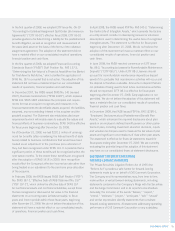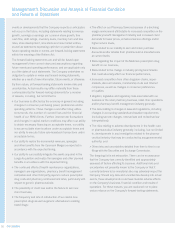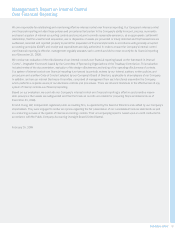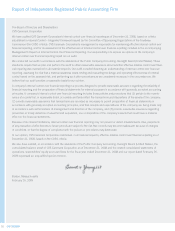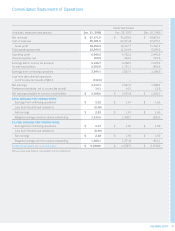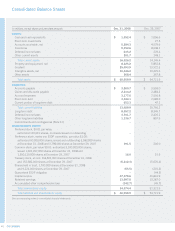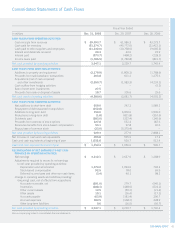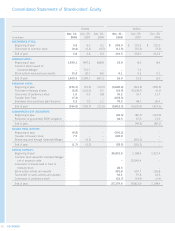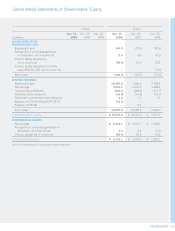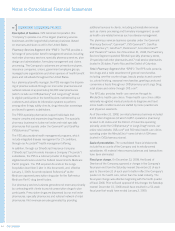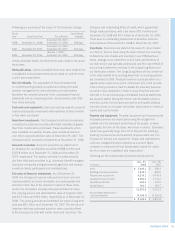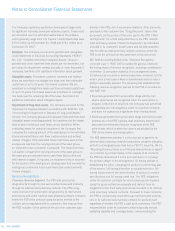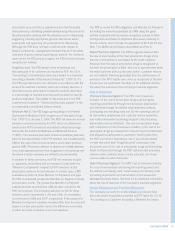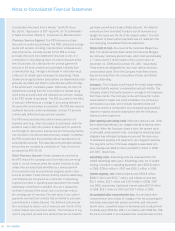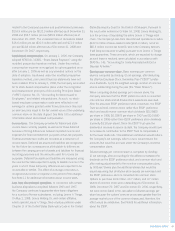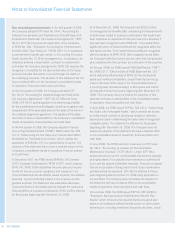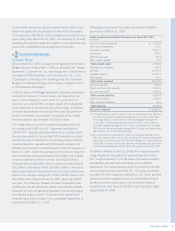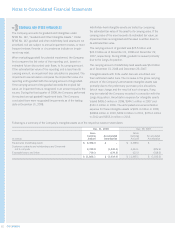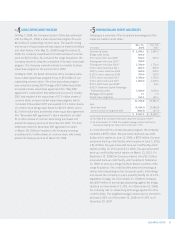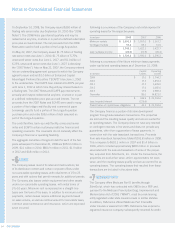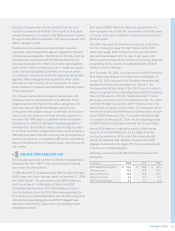CVS 2008 Annual Report Download - page 49
Download and view the complete annual report
Please find page 49 of the 2008 CVS annual report below. You can navigate through the pages in the report by either clicking on the pages listed below, or by using the keyword search tool below to find specific information within the annual report.
2008 ANNUAL REPORT 45
Company had outstanding letters of credit, which guaranteed
foreign trade purchases, with a fair value of $7.0 million as of
December 31, 2008 and $5.7 million as of December 29, 2007.
There were no outstanding investments in derivative fi nancial
instruments as of December 31, 2008 or December 29, 2007.
Inventories. Inventories are stated at the lower of cost or market
on a fi rst-in, fi rst-out basis using the retail method of accounting
to determine cost of sales and inventory in our CVS/pharmacy
stores, average cost to determine cost of sales and inventory in
our mail service and specialty pharmacies and the cost method of
accounting to determine inventory in the Longs Drug Stores and
our distribution centers. The Longs Drug Stores will be conformed
to the retail method of accounting when their accounting systems
are converted in 2009. Physical inventory counts are taken on a
regular basis in each store and a continuous cycle count process
is the primary procedure used to validate the inventory balances
on hand in each distribution center to ensure that the amounts
refl ected in the accompanying consolidated fi nancial statements
are properly stated. During the interim period between physical
inventory counts, the Company accrues for anticipated physical
inventory losses on a location-by-location basis based on historical
results and current trends.
Property and equipment. Property, equipment and improvements
to leased premises are depreciated using the straight-line
method over the estimated useful lives of the assets, or when
applicable, the term of the lease, whichever is shorter. Estimated
useful lives generally range from 10 to 40 years for buildings,
building improvements and leasehold improvements and 3 to
10 years for fi xtures and equipment. Repair and maintenance
costs are charged directly to expense as incurred. Major
renewals or replacements that substantially extend the useful
life of an asset are capitalized and depreciated.
Following are the components of property and equipment:
Dec. 31, Dec. 29,
In millions 2008 2007
Land $ 1,304.1 $ 586.4
Building and improvements 1,343.1 896.0
Fixtures and equipment 6,216.1 4,947.4
Leasehold improvements 2,581.3 2,133.2
Capitalized software 665.6 474.6
Capital leases 181.7 181.7
12,291.9 9,219.3
Accumulated depreciation
and amortization (4,166.7) (3,366.5)
$ 8,125.2 $ 5,852.8
Following is a summary of the impact of the fi scal year change:
Fiscal Fiscal Period
Year Fiscal Year-End Fiscal Period Includes
December 30, 2007 –
2008 December 31, 2008 December 31, 2008 368 days
December 31, 2006 –
2007 December 29, 2007 December 29, 2007 364 days
January 1, 2006 –
2006 December 30, 2006 December 30, 2006 364 days
Unless otherwise noted, all references to years relate to the above
fi scal years.
Reclassifi cations. Certain reclassifi cations have been made to the
consolidated fi nancial statements of prior years to conform to the
current year presentation.
Use of estimates. The preparation of fi nancial statements
in conformity with generally accepted accounting principles
requires management to make estimates and assumptions
that affect the reported amounts in the consolidated fi nancial
statements and accompanying notes. Actual results could differ
from those estimates.
Cash and cash equivalents. Cash and cash equivalents consist of
cash and temporary investments with maturities of three months
or less when purchased.
Short-term investments. The Company’s short-term investments
consisted of auction rate securities with initial maturities of greater
than three months when purchased. These investments, which
were classifi ed as available-for-sale, were carried at historical
cost, which approximated fair value at December 29, 2007. The
Company had no short-term investments at December 31, 2008.
Accounts receivable. Accounts receivable are stated net of
an allowance for uncollectible accounts of $188.8 million and
$107.8 million as of December 31, 2008 and December 29,
2007, respectively. The balance primarily includes amounts
due from third party providers (e.g., pharmacy benefi t managers,
insurance companies and governmental agencies) and vendors
as well as clients, participants and manufacturers.
Fair value of fi nancial instruments. As of December 31,
2008, the Company’s fi nancial instruments include cash and
cash equivalents, accounts receivable, accounts payable and
short-term debt. Due to the short-term nature of these instru-
ments, the Company’s carrying value approximates fair value.
The carrying amount and estimated fair value of long-term debt
was $7.9 billion and $6.9 billion, respectively as of December 31,
2008. The carrying amount and estimated fair value of long-term
debt was $8.2 billion as of December 29, 2007. The fair value of
long-term debt was estimated based on rates currently offered
to the Company for debt with similar terms and maturities. The


